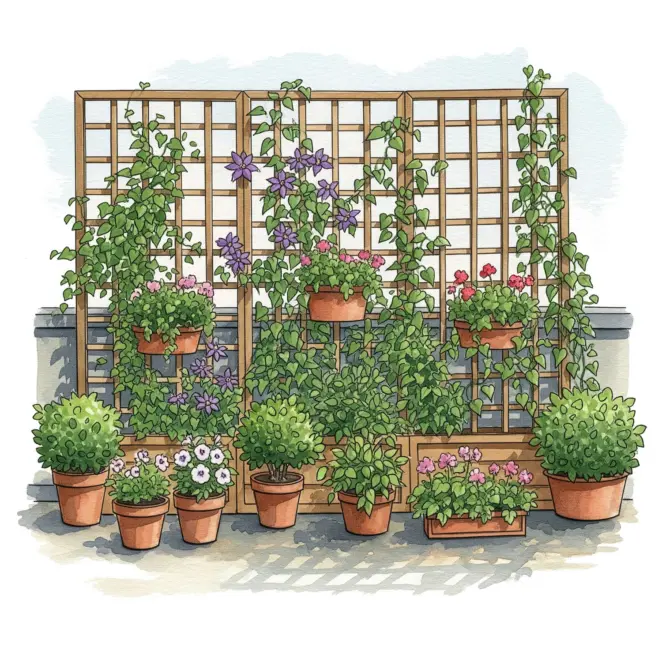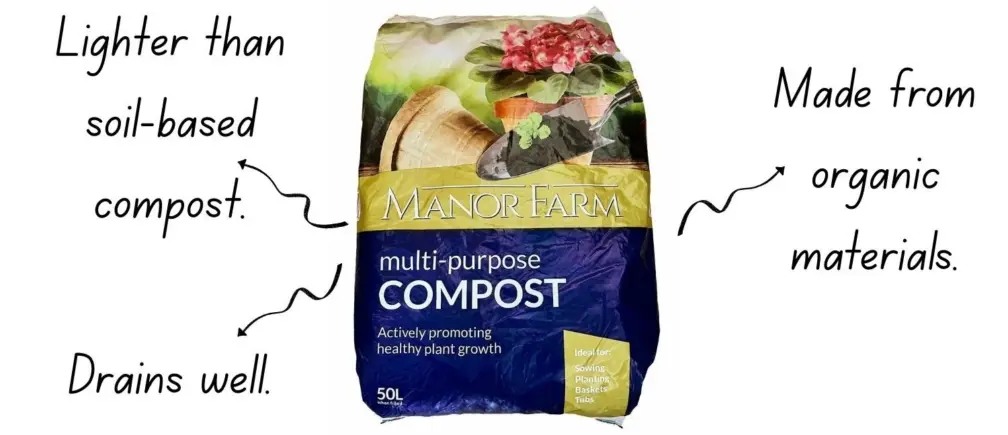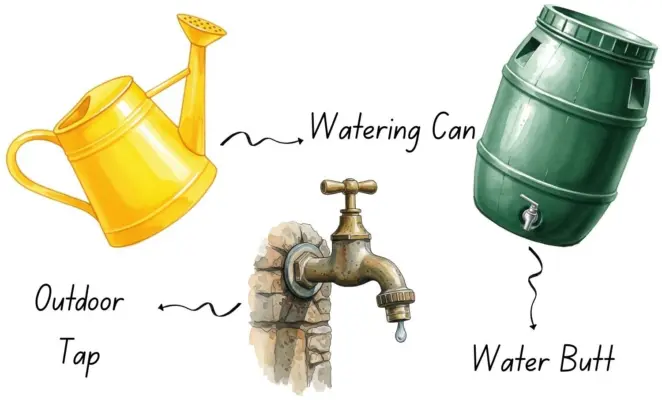Creating a Balcony or Roof Terrace Garden
Before you go ahead with any plans for a balcony or roof terrace it is essential that you check planning permission at the property you are looking to transform. Structural checks by a professional will also need to be completed as these projects can add a lot of weight to your roof. You will also want to ensure the roof is waterproof.
Once the above has been checked and approved, follow our step-by-step guide to transform your old balcony or roof into a new beautiful utopia.
.: Plan Your Space
Before you start creating your dream green space, take a few minutes to plan it out properly. A little preparation will make sure your garden feels welcoming and balanced.

To do this, sketch a simple layout showing where planters, furniture, and any décor will go. One of the best ways to do this is to divide your new garden into areas.
Depending on your needs, these can include:
- Flower area – to add a pop of colour to the space and encourage pollinators to visit your space.
- Herb or vegetable area – perfect if you want to grow your own food and have access to your fresh produce.
- Relaxation area – this can include a seating or dining zone that allows you to spend some time appreciating your green haven.
This approach helps you decide how much space you want to give to each area and helps you avoid common mistakes, such as buying too many plants, leaving you with no room to sit and enjoy them, or leaving parts of your roof or balcony empty and unused.
.: Provide Shelter From the Wind
Once you have planned where you want your plants to go – assess whether they need to be shielded from the wind.
Even if your roof is only on the second or third floor, the extra height can expose your garden to strong winds, meaning your plants will have a tougher time surviving. This is especially true for perennials, shrubs, and evergreens, as these often fall victim to what is known as wind scorch. According to the RHS, ‘scorched leaves have brown, desiccated edges or may be entirely brown and dry’.
To prevent it, try to filter at least half of the wind by adding windbreaks to the garden. These can be made with materials such as netting, and due to the rising popularity of roof terraces, pre-made windbreaks can now be purchased relatively cheaply.
For a more attractive solution, consider installing trellis panels. These are wooden frameworks that can also be used to support the growth of climbing plants or simply painted to add a pop of colour or match the style of your garden. They can also be used for privacy screening, blocking any unwanted views or restricting the view into the garden from other people.

.: Choose the Right Containers
Since your balcony or roof can only hold a limited amount of weight safely, choosing the right containers is very important.

Terracotta planters are an ideal choice, especially for Mediterranean plants such as lavender or rosemary. These breathable pots offer excellent drainage and prevent root rot. However, they are very heavy, making them unsuitable for certain balconies and roof terraces.
Polystone and fibreglass planters are lightweight yet durable, making them an ideal option for spaces where weight is a concern. They are also non-porous, so the soil inside them doesn’t dry out as fast as it does in terracotta pots. This makes them a perfect choice if you prefer to water your plants less frequently. Additionally, there are endless varieties and options now available, often at a fraction of the price of terracotta pots. This means you can find something that suits both your plants’ needs and your garden’s aesthetic, no matter your budget.

Once you have chosen the type of container that works best for you, think about designs that could help you use your space to the fullest. If space is limited, consider creating different levels using vertical planters, shelves, or hanging baskets. Raised planters are another way to add height and dimension, and they can be used to create designated flower, vegetable, or herb sections.
.: Buy the Right Soil
Choosing the right soil or compost is just as important as choosing the right pot.
A soil-based compost is often the best choice. It holds water and nutrients well and releases them slowly because it contains real loam. As a result, it does not dry out as quickly and stays more stable, making it a good option if you plan to keep your plants in the same pots for a long time. However, because it is heavier, it may not be suitable for some balconies and roofs.
If you need a lighter option, choose a high-quality multi-purpose compost or a peat-free alternative. These mixes contain no soil and are usually made from organic materials like peat (or peat substitutes), coir, and wood fibre. They drain well, which helps prevent root rot, but your plants will need to be watered more often.

Once you have decided which option is right for you, depending on the access to your space, you can bring the soil up in smaller loads using buckets, a wheelbarrow, or rent a hiab for larger amounts.
.: Provide a Water Supply
Plants grown in containers are more prone to drought than those planted in the ground because the soil dries out faster and the roots have less space to draw moisture from. To keep them healthy, make sure you water them regularly.
For this, you will need a reliable water source.
Ideally, your balcony or roof terrace already has an outdoor water tap, or you can arrange to have one installed.
If that is not possible, think about using a water butt to collect rainwater. This is better for the environment because it reduces the demand on reservoirs and water sources used by wildlife. Rainwater is also healthier for plants as it contains fewer salts and chemicals than tap water. However, water butts can be extremely heavy. A 200-litre water butt will weigh around 200 kilograms, so if you are conscious about your roof's capacity, it's best to choose another water source.
If your garden is close to an indoor tap, you can carry water using a watering can. However, this can be time-consuming if you have many plants - especially in summer, when watering may be needed twice a day due to the soil drying out.

.: Choose Your Plants
Mediterranean and coastal plants are usually the best choice since they are naturally adapted to windy conditions and handle drought well.

Yuccas tend to be popular since they have narrow leaves, which catch less of the wind’s force and reduce the amount of damage that it can cause to the plant. Natively, yuccas grow in coastal regions and handle drought extremely well, often thriving in sand dunes.
Lavender is another excellent choice. The plant is native to the Mediterranean, Middle East, and North Africa, and loves a hot, dry climate. Additionally, lavender attracts multiple beneficial pollinators, such as honeybees, bumblebees, carpenter bees, moths, and butterflies. It is also known for its floral and sweet scent that will positively contribute to the ambience of the space.
Other good plants include cotoneaster, climbing hydrangea, maiden grass, ajuga, Japanese wisteria, and daylily.
For best results, choose plants that bloom at different times of the year so that your space stays visually interesting and welcoming in any season. Colours are important too. Decide if you want as many as possible to really brighten up the space or come up with a colour palette that works best for you and use it throughout the garden.
If you prefer to grow vegetables, try growing Swiss chard if your new garden tends to be shadier, or sweet peppers if it’s on the sunnier side. Both are known to do extremely well when planted in containers.
Alternatively, you may want to consider artificial plants to reduce the amount of maintenance needed to keep your garden looking its best. Choose ones specifically designed for outdoor use, as they will have higher UV resistance and cope much better with challenging weather conditions such as high winds or heavy rain.
With the right plan, pots, plants, and a good watering system, you too can turn your balcony or roof into a beautiful green space. Fill it with vibrant colours and fragrant flowers to create a peaceful haven for you and your loved ones.
Are you ready to get started? Check out our ‘Top 10 Small Garden Ideas’ blog for more inspiration on making the most of every inch of your space!


